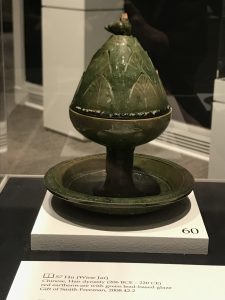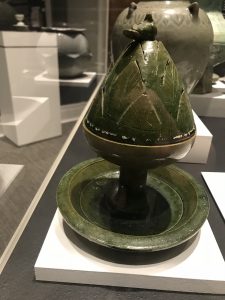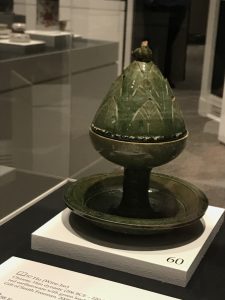“A literal artichoke on a pedestal,” my friend mentioned as I took a picture of the small, forest green object encased alongside other green vessels from Asia. I had seen it before, but this was the first time I truly acknowledged its peculiar aesthetic qualities. Jokes aside, the earthenware vessel does actually resemble an artichoke perched atop a bird feeder. In fact, upon first glance my logical guess for the object’s function was a bird feeder. A shallow dish forms the base of the ceramic piece, perhaps denoting the possibility of holding enough water to nourish a small creature. Yet a short, connected stem separates the shallow base dish from an even smaller, curvilinear bowl that both balances the artichoke-shaped form and squashes any chance a creature beyond the size of a hummingbird could adequately and comfortably refresh themselves while perched on the rim of the base dish.
Further diminishing any hope that the object was meant for avian drinking is the bulbous, artichoke shaped mound that is perched atop the open-faced bowl. The artichoke – here on referred to as the hill – is shaped like a tapered pyramid. The white scratch marks that circle the entire circumference of the bottom of the hill reveal that the piece was at one point forcibly placed into the open bowl, hinting that something was put inside and covered by the bird-mounted hill. Furthermore, there are small triangular slits decorated with diagonal markings that decorate the entirety of the hill. Each slit has been slightly pushed outwards, away from the hill-shaped form. The slits remind one of artichoke hearts or fish gills; they form a cohesive textured coat that functions on both practical and metaphorical planes. As decoration, they look like leaves. A singular line juts down the middle of each leaf-shaped slit and multiple diagonals branch off downward from the center line to the edges. Like leaf veins, the slits seem structured yet natural. The green glaze, too, functions as a sort of vegetal metaphor and points to the possibility that this object either belongs in the natural world or mimics the natural world’s processes.
The piece was obviously made in multiple phases. While the base dish and top bowl were most likely thrown, the mounded hill and stem seem hand-built or sculpted. The differences in form most likely mean that each piece serves an integral part in the object’s function. Upon consulting the object guide, the object is a rare surviving example of a hill censer, or incense burner. The raised bowl would be filled with sweet incense, lit, and then the hill form would be placed snuggly on top. The decorative slits allowed for the incense’s sweet aromas to flow. The excess incense, if there was any, would drip to the bottom and fill the shallow base dish.
The green color, mounded shape, decorated triangular slits, and miniature perched bird visually integrate the incense burner’s functional value alongside site-specificity. Indeed, the location evoked by the object’s formal qualities – a mountain top with trees – is the exact place in which the burner would most likely be placed. Serving a ceremonial purpose, the mountain censer was often placed leading to or around a Taoist temple. Most likely the object references Mount Bo, an important site in the Taoist afterlife. The gradual emittance of the incenses’ smoke would have created an illusion of the mystical clouds which are often depicted visually as swirling around the spiritual top of Mount Bo. This disorientation of scale – a small vessel representing a mountain of epic proportions – is furthered by the small sedentary bird perched atop the mount.
The hill censer, or boshan lu, thus relies on both its material and visual qualities to function. The material choice to use red earthenware was strategic due to the high heat emitted from incense burning; the green glaze bound the object metaphorically to the natural world; the decorated slits acted as a ventilation system as well as recall the spiritual mountain the object seeks to evoke. Integrated on material, functional, and metaphorical modes, the hill censer eludes but does not shy away from making its methodology visually known.


